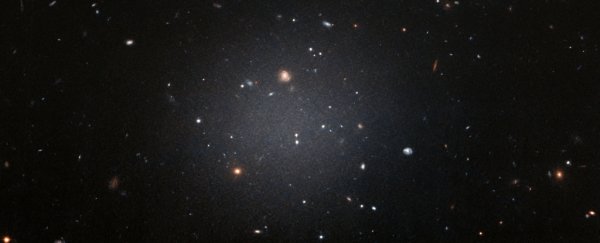A huge discovery that was incompatible with our current theories of dark matter and galaxy formation may have just been resolved.
After a new analysis, astronomers have determined that NGC1052-DF2 - found last year to contain absolutely no dark matter - is a lot closer to us than previous calculations estimated. Which means that it likely does have dark matter after all.
Dark matter is a looming great big question mark over the Universe. We don't know what it is, and we can't detect it directly, but we know there's something out there creating the same effect as mass in the Universe.
Objects in galaxies, for instance, move faster than they should based on the mass we can directly detect; some undetectable force - some dark matter, if you will - is generating more gravity than we can account for with normal matter.
This stuff is fundamental to our understanding of the Universe. We believe it helped stars and galaxies form from the primordial soup that existed just after the Big Bang, and that it helps keep the stuff in galaxies from just flying off into space.
And our galaxy formation model depends on it.
"For decades, we thought that galaxies start their lives as blobs of dark matter," astronomer Pieter van Dokkum of Yale University said last year.
"After that everything else happens: gas falls into the dark matter halos, the gas turns into stars, they slowly build up, then you end up with galaxies like the Milky Way. NGC1052-DF2 challenges the standard ideas of how we think galaxies form."
Dark matter, therefore, seems to be a pretty critical ingredient, and, indeed, until the discovery of NGC1052-DF2, every galaxy seemed to have at least some. In fact, most seem to have more dark matter than normal matter.
So an international team of researchers led by the Instituto de Astrofísica de Canarias (IAC) decided to take a closer look. And they found that all the anomalous measurements in the previous research that pointed to an absence of dark matter were reliant on the distance to the galaxy - 64 million light-years away.
This gave them something to work with. Using five separate methods, including photometry from the Hubble Space Telescope and the Gemini Observatory, they recalculated the distance to NGC1052-DF2.
Each method turned up the same result - NGC1052-DF2 is much closer than 64 million light-years away. According to the team's multiple calculations, a more accurate distance would be around 42 million light-years.
Based on this new distance, the mass of the galaxy is about half of what it was thought to be previously - and the mass of the stars is only about a quarter of what previous analysis suggested.
So, not only does the galaxy itself have less mass, but the proportion of normal matter within that mass is smaller. This implies that the rest must be made up of - you guessed it - dark matter.
On top of the calculations, the lack of dark matter had previously been inferred based on the slow movement of star clusters within the galaxy. With less mass in the galaxy overall, this movement speed is actually pretty normal.
"With this revised distance," the researchers wrote in their paper, "the galaxy appears to be a rather ordinary low surface brightness galaxy with plenty of room for dark matter."
Now, this is not the end of the tale. We are yet to see if a similar numbers issue also affects NGC1052-DF4, a galaxy calculated to be close to DF2 at around 63 million light-years away, that van Dokkum's team has found to also have no dark matter.
The researchers behind this latest finding are already working on it, and it looks like a pretty similar result is incoming. As physicist Mireia Montes from the University of New South Wales, Australia told ScienceAlert in an email, "their results also are telling us that NGC1052-DF4 is closer to us than what [van Dokkum's] team has inferred."
Watch this space: After all, science at work is a beautiful thing.
The research has been published in the Monthly Notices of the Royal Astronomical Society.
